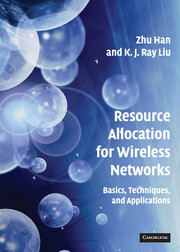Book contents
- Frontmatter
- Contents
- Preface
- 1 Introduction
- Part I Basics Principles
- Part II Optimization Techniques for Resource Allocation
- Part III Advanced Topics
- 10 Resource Allocation with Antenna-Array Processing
- 11 Dynamic Resource Allocation
- 12 Resource Allocation for Cooperative Networks
- 13 Game-Theoretic Approaches for Resource Allocation
- 14 Ad Hoc/Sensor/Personal-Area Networks
- 15 Resource Allocation for Wireless Multimedia
- Bibliography
- Index
10 - Resource Allocation with Antenna-Array Processing
from Part III - Advanced Topics
Published online by Cambridge University Press: 05 August 2012
- Frontmatter
- Contents
- Preface
- 1 Introduction
- Part I Basics Principles
- Part II Optimization Techniques for Resource Allocation
- Part III Advanced Topics
- 10 Resource Allocation with Antenna-Array Processing
- 11 Dynamic Resource Allocation
- 12 Resource Allocation for Cooperative Networks
- 13 Game-Theoretic Approaches for Resource Allocation
- 14 Ad Hoc/Sensor/Personal-Area Networks
- 15 Resource Allocation for Wireless Multimedia
- Bibliography
- Index
Summary
Introduction
Because different users have different channels and locations at different times, resource allocation can take advantage of the time, frequency, multiuser, and spatial diversity. Specifically for spatial diversity, transceivers employ antenna arrays and adjust their beam patterns such that they have good channel gain toward the desired directions, whereas the aggregate interference power is minimized at their output. Antenna-array processing techniques such as beam forming can be applied to receive and transmit multiple signals that are separated in space. Hence multiple cochannel users can be supported in each cell to increase the capacity by exploring the spatial diversity. Many works have been reported in the literature. Traditional beam formers such as minimum-mean-square-error (MMSE) and minimum-variance-distortion-response (MVDR) methods have been commonly employed [130]. Many joint power-control and beam forming algorithms are proposed in [183, 203, 248, 250]. The application of antenna arrays has been proposed in [214] to increase the network capacity in CDMA systems.
In this chapter, we first consider the resource-allocation example that jointly considers the antenna-array processing. We consider a system with beam forming capabilities in the receiver. An iterative algorithm is proposed to jointly update the transmission powers and the beam-former weights so that it converges to the joint optimal beam-forming and transmission power vector. The algorithm is distributed and uses only local interference measurements. In an uplink transmission scenario it is shown how base assignment can be incorporated in addition to beam forming and power control such that a globally optimum solution is obtained. The network capacity and the saving in mobile power are then evaluated through numerical study.
- Type
- Chapter
- Information
- Resource Allocation for Wireless NetworksBasics, Techniques, and Applications, pp. 227 - 262Publisher: Cambridge University PressPrint publication year: 2008



